THE Museum has recently added to its collections representing the wood-sculpture of Upper Guinea several remarkable examples from French territory in or adjoining that region. Two of these are figured here and described, with some additional comment.
I
The statuette shown first is in several respects the more interesting, in that it exemplifies qualities which, in combination, appear broadly to distinguish the sculpture of the Western Sudan from that of other parts of Africa.
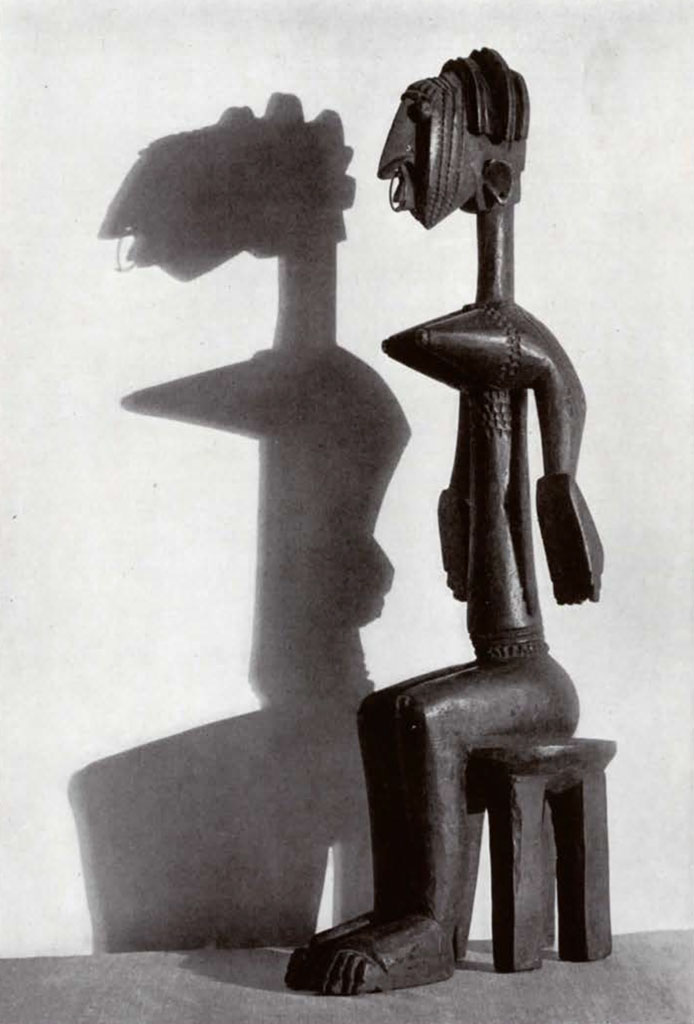
Museum Object Number: AF5365
Image Number: 995
In general treatment the figure is unmistakably negro. There is the characteristic avoidance of details which are not conceived as important, such as the musculature of the trunk and limbs, with the almost diagrammatic rendering of outlines which necessarily accompanies this; the bold and well-balanced disposition of masses; the simple and vigorously direct statement of the sculptor’s conception of his subject as a whole. There is also, applied in this case especially to the nose, breasts, hands and feet, that exaggeration or intensification of nature which the negro artist employs to give value to peculiarities regarded as significant for distinctiveness, racial, perhaps, or otherwise symbolical; a device which, handled as it is here with a craftsmanship fairly to be called polished, has all the sophistication of the methods of an occidental master of caricature, though without the latter’s consciously humorous prepossession. It is as if a Max Beerbohm, trained to see angles rather than curves, and purged of malice, should undertake the portrait of a famous diva.
The specific features alluded to, which the statuette has in common with other examples of Western Sudanese wood-sculpture, are in reality forms of this treatment, and so do not deprive it of the right to remain within a truly African category. These characters are an extreme slenderness and a bizarre modification of parts of the object as it is represented into forms suggestive of the distinctive traits of some other creature. So, in this instance, the hands and feet have been turned into forms clearly intended to suggest the paws of an animal. In another class of images, typical of a part of the French Sudan not very distant from the place of origin of this figure, the slender muzzle of an antelope goes over, in some cases, into the semblance of the long curved bill of a bird, while the rest of the animal though highly stylized into a corresponding extreme of slenderness retains at least some of the parts, often much simplified, which characterize the original conventionalization of an antelope.1 The operation of the same tendencies may be seen in certain facial masks from the interior of the Ivory Coast.2
In the absence of definite information as to the history or place of origin of this statuette either from the former owner or to be obtained, so far as the writer knows, from the literature on the French Sudan, satisfactory identification seemed difficult. There is an almost identical figure in the British Museum which is said to have come from Sierra Leona, but a communication from Mr. Braunholtz of the Department of Ethnography characterized this attribution as doubtful and referred to a similar figure in the Museum of the Trocadéro in Paris. The following extract from a letter from Dr. R. Verneau is, I believe, decisive as to the provenience of the statuette:
“The Ethnographic Museum of the Trocadéro has a wooden statuette which is very similar to yours. It has the same neck, trunk, breasts, arms, and hands. It is in a standing, not a sitting, posture. The head, however, and especially the coiffure, show certain differences; but I think it must come from the same region as yours. It was found in a ruined hut at Bouganoura in Khasso….
“There are in the Museum of the Trocadéro other wooden statuettes very similar in design to the one which the University Museum of Philadelphia has purchased. They come from the region included between the Upper Senegal, the southwestern extremity of the French Sudan, and French Guinea; that is, from the region situated to the east of the Upper Gambia and Portuguese Guinea.” This must mean, roughly, the triangular portion of the French Sudan (officially, “Upper Senegal-Niger”) bounded on the northeast by a fairly straight line drawn through Kayesand Bafoulabe—so as to include the district of Khasso—to the point where the river Baknoy leaves French Guinea, on the west by Senegal, and on the south by French Guinea.
In view of the fact that Dr. Verneau considers the Trocadéro statuette from Khasso to be the one which most closely resembles the figure here, it is possible that the latter is the work of a Khassonke artist. The racial composition of the Khassonke as given by Delafosse is of interest in this connection.
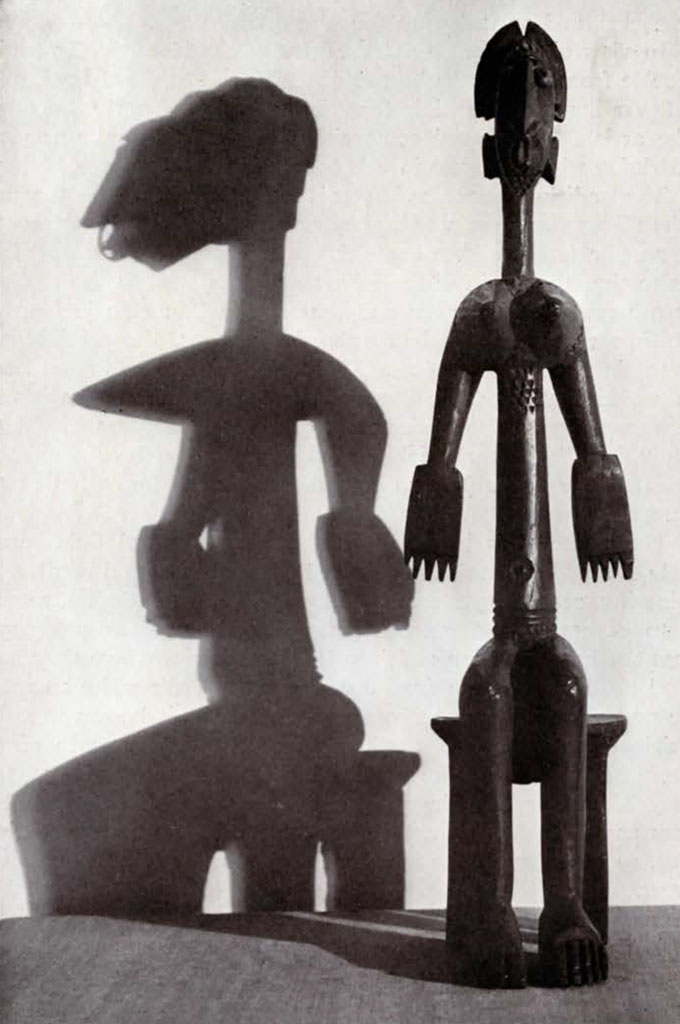
Museum Object Number: AF5365
Image Number: 993
The tradition current at Kayes is to the effect that the ancestors of the Khassonke were a Fula shepherd and a Banmana (Bambara) woman of a family whose herds the Fula guarded. Delafosse is of opinion that the origin of the Khassonke goes back to the tenth or eleventh century of our era and that as the Banmana had not at that time reached the neighbourhood of Kayes, the chief Mande element in the ancestry of the Khassonke referred to in the tradition would really be not Banmana but Kagoro, another Mande group speaking a dialect which greatly resembles Khassonke. Moorish (aboriginally Berber), Malinke and Soninke (Mande or Mandingo) elements have probably also contributed to the formation of the Khassonke.3
The Fulbe—this is the plural form of the word Fula—are a people of the Western Sudan of mixed white and negro descent, who, originating, according to some writers in the central Sudan, according to others in the extreme west, have spread as conquerors across the French Sudan and into British Nigeria, where they have ousted the Hausa as the dominant element. Their white ancestors were probably Berbers, the race which so far as is known were the aboriginal inhabitants of northern Africa, or at any rate of the western half of it. The negro4 element in their ancestry is probably chiefly Mande or Mandingo. In the opinion of Delafosse and of others as well,4 there is a Semitic element in the ancestry of the Fulbe, so that their white blood would be drawn from at least two sources.
In the negroid peoples of the Sudan a portion of their racial inheritance on the dark side which becomes more and more predominant the further south one moves is undoubtedly supplied by an element akin to the tall, slender negroes of the Upper Nile valley. This would be sufficient perhaps to account, on the realistic side, for the slenderness of figure emphasized in the statuette. But the shape of the face and the outline of the features—especially the nose—apart from the recession of the chin, are anything but negro; indeed there is every appearance of a distinct intention to mark this fact and to bring out the side of Sudanese ancestry which was not originally marked by the typically Sudanese dark shade of colouring. And the shape of face and features points not to a Berber but rather to a Semitic strain, which would also be fitly indicated by the tall slenderness of the figure. In any case the general appearance of the figure suits well with descriptions of individuals in Sudanese groups which boast of Fula ancestry.
Though the region of origin of the statuette may be regarded as satisfactorily settled, the group in which it originated cannot be so certainly determined. For not only Khassonke but other related groups inhabit this triangular corner of the French Sudan. Racially, however, the composition of all these tribes is similar, and the type of features in question, though no doubt idealized in statuettes of this nature, may be expected to occur not infrequently; and as the element of ancestry represented by these traits is valued, the latter find their place naturally in images of this class among peoples who have a tendency towards what is often called ancestor worship.
The religious observances of these tribes include a feature which is quite general. This is the worship of a triad of divinities, father, mother, and child. The father is the sky god, sometimes identified with the sun, the mother is the earth, sometimes identified with the moon, and their offspring are genii who have power over the world and over life and death, happiness and misfortune. According to Delafosse, the parental pair are divinities of fecundation and fertility, and they are invoked in oaths and in the expression of wishes. Their worship, he says, is less important than that of their eldest child, the third member of the triad, who is sometimes represented as bisexual, possessing both the male and the female powers of his parents, and who is the real intermediary between man and the supreme god. The latter is usually identified with the sky god, though, says Delafosse, the old people attribute to their high god a special name known only to themselves, which is not the name of the sky.
Is this figure to be regarded as representing the goddess of the earth, or moon, or is it a memorial to a deified or semideified ancestress? The founder of a family is venerated. Gradually ancestors are transformed into true heroes or demigods having cults which are confined to groups of real or putative descendants, a family, clan, subtribe, or tribe.
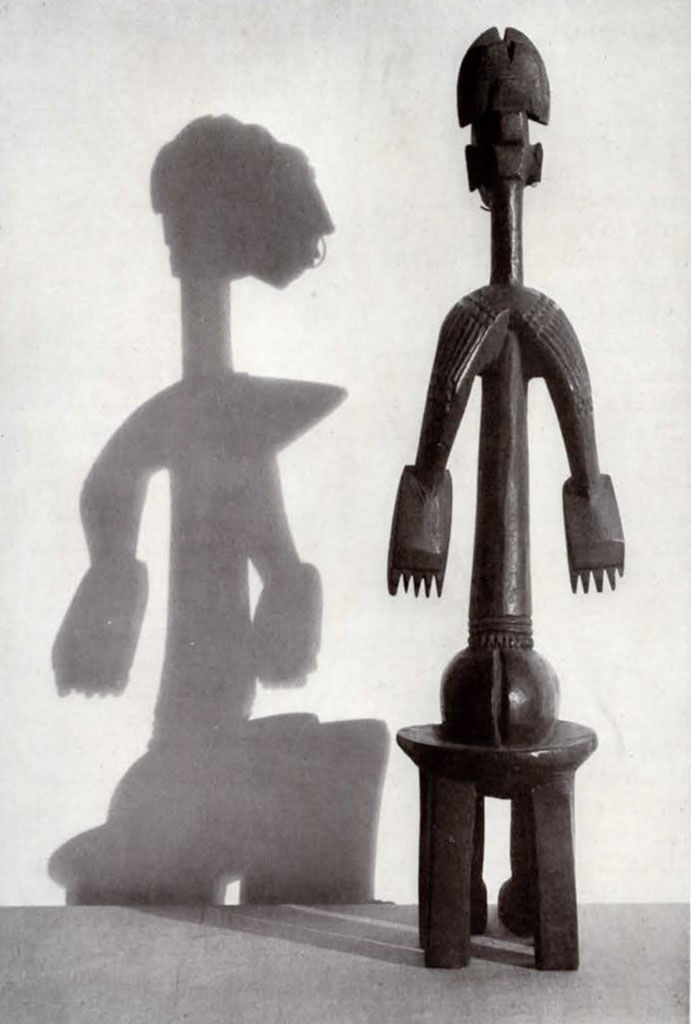
Museum Object Number: AF5365
Image Number: 996
But, apparently, the deified ancestors of the larger groups, the clans or tribes, are not represented by figures of this kind but reside in sacred trees or shrubs, to which offerings are made of feathers, blood, and eggs. The altar to the tutelary spirit of a family is erected in the dwelling and images representing the ancestors are often placed about it; these are made of wood, clay, iron, or bronze. Such images, however, are not likely to be of the generalized pattern to which our statuette clearly belongs. Probably, then, we are to exclude as possible originals which it could represent both ancestral demigods of clans or tribes and ancestors of the family. There remains the strong probability that we have here a representation, in terms of the characters regarded as most desirable in one’s ancestry, of the mother goddess of whose attributes it is said—and this surely adds weight to the probability—that ” the Earth or female genius is represented as a woman with immense breasts or simply by means of a pair of breasts.”5
It does not seem satisfactory to attempt to explain the peculiar form given to the hands and feet simply as a conventionalization of those of a human being. Their size and bulky appearance are too strongly contrasted with the otherwise prevailing impression of slenderness obtained from the figure, in view especially of the fact that these people are not noted for the large size of their extremities. There is besides an evident intention to convey the impression that they represent the fore and hind feet of an animal.
The social organization of most of these tribes includes a number of groups each marked by the possession of a Lana or taboo, usually one which forbids the killing of a certain animal, and by a prohibition against marriage between members of the group. There are also subsidiary taboos which are common to members of the same group. Among the animals which, in one tribe or another, are the objects of a Lana, are the hippopotamus, the lion, and the crocodile. Delafosse declares that there is no representation in the art of the object tabooed,6 but it is difficult to decide whether this statement can be considered inclusive enough to cover the modification of parts of a statue to indicate, say, the limitation in use of one form of the statue of a goddess to an exogamous group having the animals designated by such modification as a tans. This can be regarded as no more than a suggestion. Its possible validity is not aided by the apparent lack of any necessary connection between the tams and religion. On the other hand, a statement made by Delafosse in connection with the correct name of the people commonly known to Europeans as Bambara, may also have some bearing on the problem. He says that the word Bambara may be derived from the Mande term for a crocodile, bamba or bamma, and that all the peoples whom the Moslems group under the name Bambara, that is, all the peoples of this part of the Sudan, have the crocodile as a “religious emblem.”7 The hands, at any rate, of this statuette bear some resemblance to the claws of a crocodile. I am, however, unable to suggest any reason why the crocodile should be connected with the deity who is probably represented here.
The ornamental cicatrization of the shoulders, breast, and waist is of a nature represented in more than one Sudanese group. The descriptions of coiffures with which I am familiar do not allow of the exact identification of the pattern illustrated here. Neither of these features, which sometimes assist in the identification of examples of African wood-sculpture, is, therefore, of assistance here. The stool, of a somewhat generalized form, is no more than an indication of rank.
II
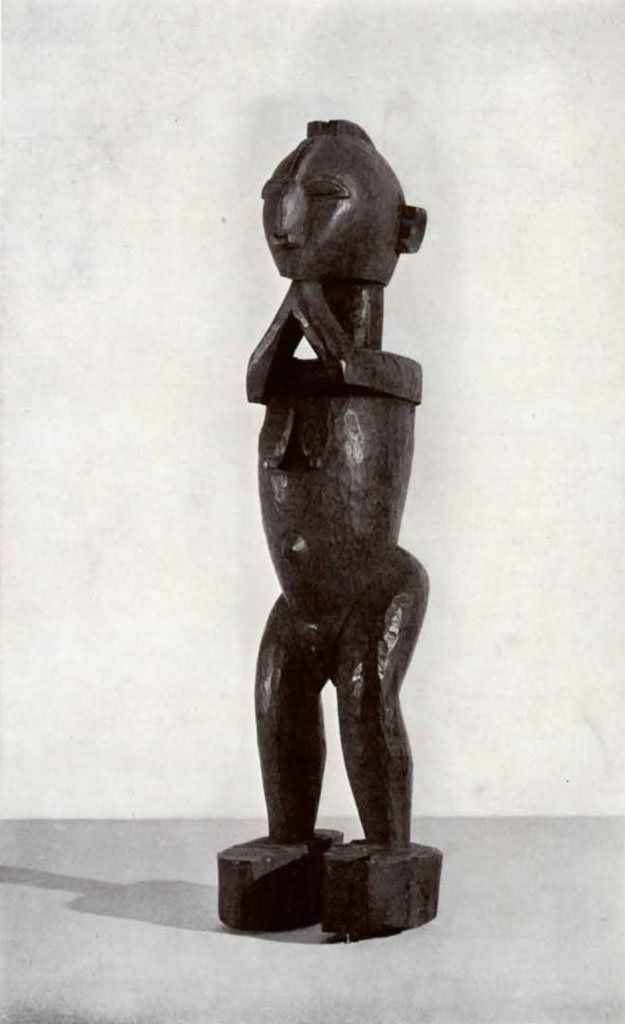
Museum Object Number: AF5374
Image Number: 979
The second figure pictured here is from French Guinea, and specifically, from the people known as Baga or Bagga.8 These people are said to have an extremely simple and primitive mode of life and organization. They are fisherfolk and growers of rice, living in the islets at and near the mouth of the Rio Nunez—one of the streams between the river Gambia and Sierra Leone to which the region owes the name by which it is sometimes known, Rivières du Sud.
The figure is somewhat smaller than the Sudanese statuette 19 1/8 inches in height as compared to the 20 7/8 inches of the latter. It is of a cruder type in workmanship and design and less differentiated than the other from the norms of style in the general field of negro sculpture. It represents a woman of the rather stocky type of forest negro, so called, which is the type of the Guinea Coast native.
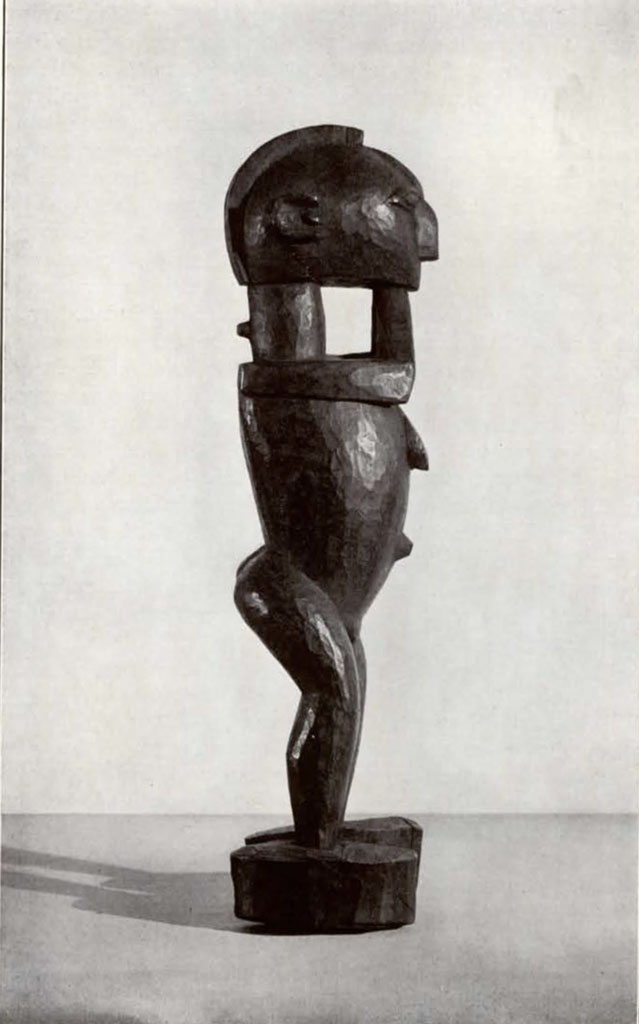
Museum Object Number: AF5374
Image Number: 981
Little is known of their beliefs and practices which might be relevant to usages connected with such images as this. In the Pitt-Rivers Museum at Farnham in Dorsetshire there are two of these statuettes, one of which figured in a war between two Baga chiefs in 1884. The defeated side attributed its misfortune to the capture of the image by the victors. This, in the absence of further particulars, is evidence merely for some kind of connection between these Baga images and military success, this obvious inference is about all that is justified in the circumstances. In a popular magazine, La Renaissance de l’Art Français, published in Paris, the issue for April, 1922, has an illustration of a drum supported by four figures almost identical in style with that shown here. Two of them apparently represent males, the others may be females, since Baga images seem to occur in pairs of this kind. Of the four supporters of a stool in the Historical Museum at Berne, two are males and two females, and there is also a pair of images at Berne both almost identical in style with the female example here, but diversely sexed.9 The drum in question is stated in the text to be a war drum and four figures supporting it are said to be “fetishes of maternity.” The original is in the Trocadéro, but it is not clear whether the statements made in the text are made on the authority of the Museum. If so, we may have here another instance of members of the West African triad of deities referred to in dealing with the Sudanese statuette; and we have also a definite connection of the Baga images with war. But fertility deities need not also be definitively gods of war; they might, as high gods and propitious in a general way, be carried into battle or associated with the summons to war given by a war drum, to ensure victory by a particular exercise of their general power.
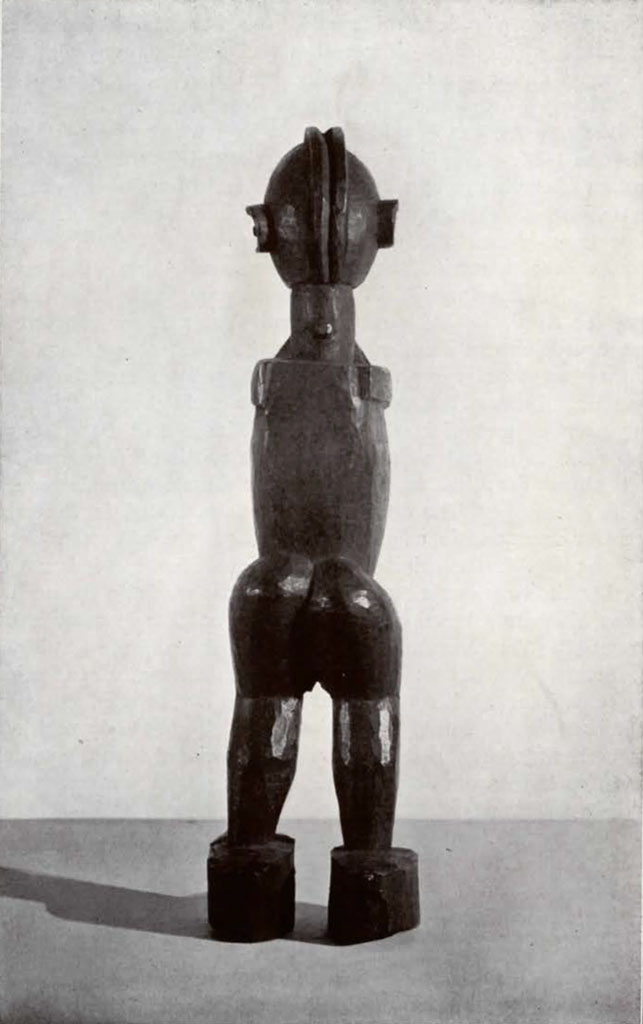
Image Number: 982
A physical feature which, in a manner, relates the Baga statuette to the Sudanese is the definitely non-negroid nose. Futa-Jallon, sometimes regarded as the area of differentiation of the Fulbe, is on the border of French Guinea, which has undoubtedly been subjected to peaceful penetration, as well as warlike, by the Fulbe.
For the loss of the hands in a convention which brings the lower arm into close juxtaposition with the lower face, leading, as here, to a loss of the mouth as well, or, in other cases to a fusing of the hands with the region of the mouth, one may compare the figures published in the MUSEUM JOURNAL for March and June, 1923, all, including the figure here, coming from different localities in western Africa.10
The double crest in a sagittal position along the otherwise shaven head must represent hair in a mode of hairdressing which in slightly varying forms is common in Africa. The similar crest down the middle of the forehead probably represents a double tress of hair plaited or plastered with grease and not a cicatrized decoration of the skin.
1M. Delafosse, Haut-Senegal-Niger: Le pays, les peoples, les langues, etc., III, Plate .31; J. Henry, Les Bambara, illustration at end entitled “Procession du Tjiwara” and the following illustration; L. Frobenius, Das sterbende Afrika, Texttafeln 12 and 13.↪
2 P. Guillaume, Sculptures nègres, Plate XIX; La Renaissance de l’art français, 5th year, No. 4, Fig. 4; L’Anthropoligie, XI, P. 440 (Delafosse).↪
3Delafosse, III, pp. 227, 289-290.↪
4Delafosse, HI, p. 216 if.; A. J. N. Tremearne, The Niger and the West Sudan, p. .33 S. Tremearne sums up the evidence, mostly based on tradition and conjecture, for a Semitic origin of the Fulbe, apart from the relatively small Arab element in the Moorish peoples.↪
5Delafosse, III, pp. 168-174. ↪
6III, p. 181.↪
7II, p. 126.↪
8I Baga-Foreh, probably, rather than the Southern Baga or the Baga-Madouri.↪
9 For the last two see L. Frobenius, Das unbekannte Afrika, P1. 166.↪
10Figures 16, 17; cf. Fig. 12 and see Fig. 11, March, 1920.↪

